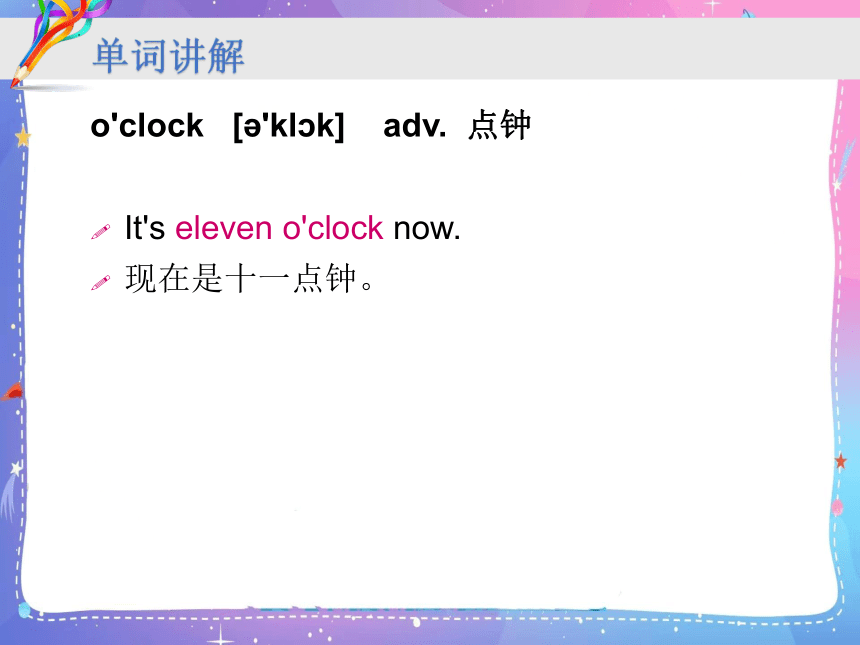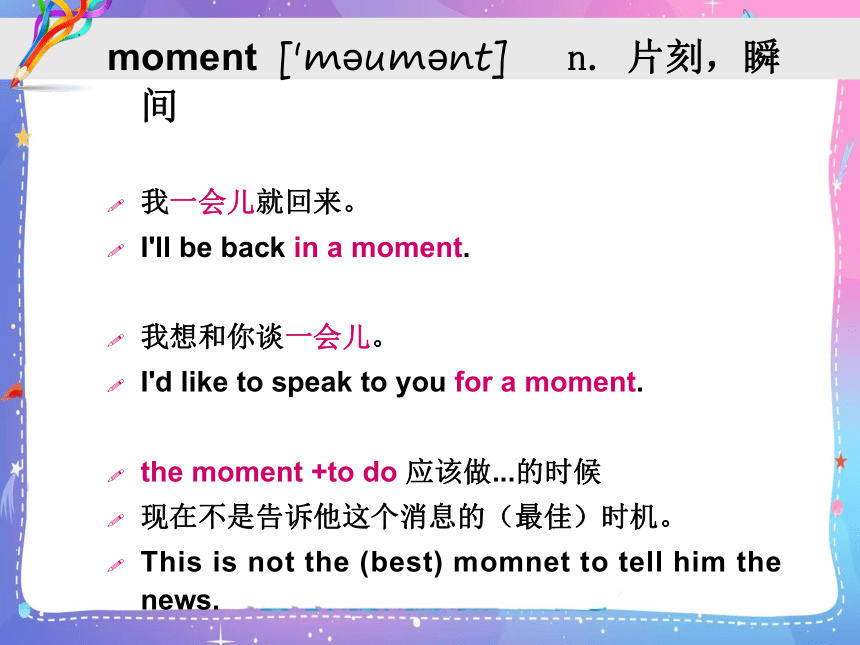新概念英语第一册Lesson57-58课件(共66张PPT)
文档属性
| 名称 | 新概念英语第一册Lesson57-58课件(共66张PPT) |

|
|
| 格式 | zip | ||
| 文件大小 | 8.1MB | ||
| 资源类型 | 教案 | ||
| 版本资源 | 新概念英语 | ||
| 科目 | 英语 | ||
| 更新时间 | 2022-06-02 07:07:56 | ||
图片预览












文档简介
(共66张PPT)
新概念Lessson57-58
一般现在时的用法:
当主语是第三人称时,它的构成是:?
主语 + 频率副词 + 三单 + 其他
当主语不是第三人称时,它的构成是:?
主语 + 频率副词 + 动词原形 + 其他
频率副词有哪些?
always(100%)>usually(80%)>often(60%)>sometimes(40%)>seldom(20%)>hardly (10%)>never(0%)
Let's start
New words and expressions P114
o’clock adv. 点钟(整点)
shop n. 商店
moment n. 片刻,瞬间
o'clock [ 'kl k] adv. 点钟
It's eleven o'clock now.
现在是十一点钟。
单词讲解
shop [ p] n. 商店
v. 逛商店,购物,买东西
我通常星期天购物。
I usually go shopping on Sundays.
shopping list 购物单
Shopping City 商业城
TV Shopping 电视购物
Shopping online 网物
go shopping 逛街
shopping mall 大型购物中心
supermarket 超市
moment ['m um nt] n. 片刻,瞬间
我一会儿就回来。
I'll be back in a moment.
我想和你谈一会儿。
I'd like to speak to you for a moment.
the moment +to do 应该做...的时候
现在不是告诉他这个消息的(最佳)时机。
This is not the (best) momnet to tell him the news.
9
Lesson 57 An unusual day.
usual
unusual
Let's listen
你的答案
Your Answer
Question
This a story about An unusal day of the Sawyer's family
Listen carefully and answer the question -----
What do the children usually do in the evening
1
What do the children usually do in the evening
2
What are the children doing at the moment
3
What does Mr. Sawyer usually do at night
Reading the text
1
What do the children usually do in the evening
2
What are the children doing at the moment
3
What does Mr. Sawyer usually do at night
They usually do their homework.
They are playing in the garden.
He usually reads his newspaper at night.
Listen and check
1. How do the children go to school every day
A. By car. B. By bus. C. By subway. D. On foot.
2. What time is Mrs. Sawyer drinking tea
A. 8:00 B. 10:00 C. 16:00 D.21:00
3. Where are the children playing
A. In the school. B. In the living room.
C. In the garden. D. In the shops.
4. What is Mr. Sawyer doing tonight
A. He is going to school. B. He is drinking tea.
C. He is reading a newspaper. D. He is reading an interesting book.
Title: An unusual day.
unusually [ n'ju: u l ]
adv. 非常;异乎寻常地;显著地
( un 否定前缀) usually adv.通常
adj. 不寻常的;与众不同的
课文讲解
It is eight o'clock. The children go to school by car every day, but today, they are going to school on foot.
by + 交通工具
乘...
it在英语中常用来指时间、天气、温度或距离,
作“虚主语”
by boat 乘小船 by bus 乘公交 by plane 乘飞机 by ship 乘船
walk to school
课文讲解
时态?
It is ten o'clock. Mrs. Sawyer usually stays at home in the morning, but this morning, she is going to the shops.
=go shopping 逛街
时态?
It is four o'clock. In the afternoon, Mrs. Sawyer usually drinks tea in the living room. But this afternoon, she is drinking tea in the garden.
It is six o'clock. In the evening, the children usually do their homework, but this evening, they are not doing their homework. At the moment, they are playing in the garden.
=now,“现在,此刻”,
现在进行时
标志性时间状语。
It is nine o'clock. Mr. Sawyer usually reads his newspaper at night. But he's not reading his newspaper tonight. At the moment, he's reading an interesting book.
usually today
8:00 children go to school by car
10:00 Mrs. Sawyer stays at home
4:00 Mrs. Sawyer drinks tea in the living room
6:00 children do their homework
9:00 Mr. Sawyer reads his newspaper
going to school on foot
going to the shops
drinking tea in the garden
playing in the garden
reading an interesting book
语法知识:
一般现在时
现在进行时
一般现在时
第三人称复数
主语
谓语
The Sawyers live at 87 King Street.
The children go to school.
They often drink tea together.
The children come home from school.
They arrive home early.
The children always do their homework.
They go to bed.
He and his wife watch television.
动词原形:do
一般现在时
第三人称单数
主语
谓语
Mr. Sawyer goes to work.
Their father takes them to school.
Mrs. Sawyer stays at home.
She does the housework.
She always eats her lunch /sees her friends.
Mr. Sawyer usually reads his newspaper.
Mr. Sawyer comes home from work.
He arrives home late.
动词+s/es
第三人称单数时,动词要变为单三形式。
规则:1)一般直接加s look-looks
2)以s, x, ch, sh, o结尾的,加es
do-does watch-watches go-goes
3)以辅音字母+y 结尾的,变y为i,加es;
empty-empties fly-flies
4)have-has do-does be-is
一般现在时句式:表经常或习惯性的动作
肯定句: 主语(I/We/You/They)+动词+其他
e.g. I stay at home every day .
主语(He/She/It)+动词加s/es+其他
e.g. He stays at home on Saturdays.
否定句: 主语(I/We/You/They) +do+ not+动词原形+其他
e.g. I don’t stay at home on Saturdays.
主语(He/She/It)+does +not+动词原形+其他
e.g. He doesn’t stay at home on Saturdays.
一般疑问句: Do+主语(I/we/you/they)+动词原形+其他?
e.g. Do you stay at home on Saturdays
Does+主语(he/she/it)+动词原形+其他?
e.g. Does he stay at home on Saturdays
特殊疑问句:疑问词+ do/does+主语+动词原形+其他?
e.g. What do you want
What does she want
What do you do
What does she do
How do you spell it
How does he spell it
时间状语/频度副词: every day/often /always/usually/
every morning/sometimes/never
1、我们每天都上学。
2、下课后我们打扫教室。
3、有时我们在操场上踢足球 。
4、我们在学校吃晚饭。
5、他喜欢英语。
6、他是一个学生。
We go to school every day.
We clean the classroom after class.
We sometimes play football on the playground.
We have dinner at school.
He likes English.
He is a student.
Look! They are running .
Listen! Someone is singing in
the next room.
3. The Greens are watching a football
match now.
现在进行时
表示现在、说话瞬间正在进行或发生
的动作。构成:
be动词(am/ is / are) +动词ing形式
标志性词语:
look, listen, now, at present
at the moment
at this moment(在此刻)
现在进行时句式:表示正在进行的动作
肯定句: 主语+be +动词ing+其他
e.g. I am staying at home .
否定句: 主语+be+ not+动词ing+其他
e.g. I am not staying at home.
一般疑问句: Be+主语+动词ing+其他?
e.g. Are you staying at home
特殊疑问句:
疑问词+ be+主语+动词+ing+其他?
e.g. What are you doing?
时间状语: 1.now,at the moment
2. look,listen
3. 各种画面、图片以及舞台
展示的动作
Exercises
eg: What are you doing now (sing)
I’m singing.
1. What are you doing now (read a book)
I’m reading a book.
2. What are Tom and Jack doing now (ride a bike)
They are riding a bike.
3. What’s your mother doing now
(look at some pictures)
She is looking at some pictures.
改变句型(一般现在时与现在进行时互换):
1.He is swimming.(everyday)
He swims everyday.
2.Lily usually goes shopping with her friends.
Lily is going shopping with her friends.
3.What are you doing now (usually, everyday)
What do you usually do everyday
4.Does he often wash his clothes by himself
Is he washing his clothes by himself
I usually _______ (go) to school by bus.
She often _______ (watch) TV.
My father _______ (read) magazines at night.
The children _______ (do) homework in the evening.
Dennis sometimes ______ ( arrive) home with her sister.
go
watches
reads
do
arrives
39
Lesson 58 What’s the time
Look and say.
What's the time
What time is it
It's...
How to ask the time
What time is it
What’s the time
It's … o'clock. (表示整点)
past ( “过了……”,表示半点前) Ten past seven.
half (“……半”,表示半点) It's half past eight.
to (“差……”,表示半点以后)Ten to seven.
quarter (表示一刻钟)qA quarter past one.
2022/6/1
时间表达法
1.整点表示法 整点+o’clock (o’clock可以省略)
e.g.10点 ten ( o’clock)
12点 twelve (o’clock)
表示在几点 ,用介词at
at seven o’clock
at eleven o’clock
几点左右
about eight o’clock
2.非整点时间表达法:
1)顺读法(按照前后顺序逐一读出)
3:25 →three twenty –five
e.g. 10:10 ten ten
8:05 eight five
6 :45 six forty- five 12:10 twelve ten
2022/6/1
2) 倒读法
半小时前用past表示“过” 分针位置≦30
读法 分+past +点 中文译为“几点过几分”
3:25 → twenty –five past three
4:15 → fifteen past four
5:25→ twenty –five past five
半小时:half past+点钟
3:30
half past three
11:30
half past eleven
Practice 5:32 4:48 11:58 10:28 6:00
8:30 12:45 3:21 7:02 9:15
12:12 2:02 5:39 11:15 2:50
特别注意:一个半小时的表达方式:
one / an hour and a half
one and a half hours
2022/6/1
分钟大于30分钟用to表示“差”
读法(60-分)+to+(点钟+1) 中文译为“几点差几分”
3:55 five to four
6:50 ten to seven
9:49 eleven to ten
15 分钟→ a quarter 一刻钟
5:15
a quarter past five / fifteen past five
12:15
a quarter past twelve / fifteen past twelve
3:45
a quarter to four / fifteen to four
8:45
a quarter to nine / fifteen to nine
三刻钟 three quarters
根据英文在钟面上画出时间。
1. half past nine
2. a quarter past seven
3. two to two
4. ten thirty-five
在日常生活中,常用下列简单方法表示时间。
以小时、分钟为单位分别读出数字。
6:31 读作 six thirty-one
10:26读作 ten twenty-six
14:03 读作 fourteen o three
16:15 读作 sixteen fifteen
18:30 读作 eighteen thirty
23:55 读作 twenty-three fifty-five
注:时刻表上的时间大多采用24小时表示法,这样就不需要用a.m.表示上午,p.m.表示下午了。
12
1
2
3
4
5
6
7
8
9
10
11
What's the time / What time is it
What time is it
1. It’s nine forty-five.
( It’s a quarter to ten.)
2. It’s two seventeen.
( It’s seventeen past two.)
9:45
2:17
3. It’s three o’clock.
现在是三点。
4. It’s nine thirty.
( It’s half past nine. )
现在是九点半。
(现在是九点半。)
3:00
9:30
5. It’s six fifteen.
( It’s a quarter past six. )
现在是六点十五分。
(现在是六点过一刻。)
6. It’s three fifty.
( It’s ten to four. )
现在是 三点五十分。
( 现在是差十分四点。)
6:15
3:50
When does he usually shave every day
He usually shaves at seven o’clock.
everyday
shave
When is he shaving today
Today, he is shaving at eight o’clock.
shave
What does she usually do in the morning
She usually drinks tea in the morning.
in the morning
drink tea
What is she doing this morning
She is drinking coffee this morning.
this morning
drink coffee
but today he is shaving at eight o'clock.
but this morning she is drinking coffee.
but this afternoon, they are swimming.
but this evening I'm reading a book.
but tonight we're listening to the stereo.
Practice
Who _____ over there now
A. singing B. are sing C. is singing D. sing
2. It’s eight o’clock. The students _____ an
English class.
have B. having C. is having D. are having
3. Listen! The baby _____ in the next room.
A. crying B. cried C. is crying D. cries
4. Look! The twins _____ new sweaters.
A. are wearing B. wearing C. are wear D. is wearing
C
D
C
A
Choose the best answer.
5. Don’t talk here. Grandparents _____.
A. is sleeping B. are sleeping
C. sleeping D. sleep
6. Tom is a worker. He _____ in a factory. His sisters _____ in a hospital.
work/ work B. works/ work C. work/ works
7. Who _____ English best in your class
A. speak B. speaks C. speaking
8. Mrs. Read _____ the windows every day.
A. is cleaning B. clean C. cleans
B
B
B
C
1.抄L57-58单词 4英1中,默写1遍
2.微信语音:跟读L57.课文并背诵;
熟读所学课文背诵,熟记单词和语法
3.完成练习册L57-58(写作必须完成)
4.预习59的单词和课文
Homework
新概念Lessson57-58
一般现在时的用法:
当主语是第三人称时,它的构成是:?
主语 + 频率副词 + 三单 + 其他
当主语不是第三人称时,它的构成是:?
主语 + 频率副词 + 动词原形 + 其他
频率副词有哪些?
always(100%)>usually(80%)>often(60%)>sometimes(40%)>seldom(20%)>hardly (10%)>never(0%)
Let's start
New words and expressions P114
o’clock adv. 点钟(整点)
shop n. 商店
moment n. 片刻,瞬间
o'clock [ 'kl k] adv. 点钟
It's eleven o'clock now.
现在是十一点钟。
单词讲解
shop [ p] n. 商店
v. 逛商店,购物,买东西
我通常星期天购物。
I usually go shopping on Sundays.
shopping list 购物单
Shopping City 商业城
TV Shopping 电视购物
Shopping online 网物
go shopping 逛街
shopping mall 大型购物中心
supermarket 超市
moment ['m um nt] n. 片刻,瞬间
我一会儿就回来。
I'll be back in a moment.
我想和你谈一会儿。
I'd like to speak to you for a moment.
the moment +to do 应该做...的时候
现在不是告诉他这个消息的(最佳)时机。
This is not the (best) momnet to tell him the news.
9
Lesson 57 An unusual day.
usual
unusual
Let's listen
你的答案
Your Answer
Question
This a story about An unusal day of the Sawyer's family
Listen carefully and answer the question -----
What do the children usually do in the evening
1
What do the children usually do in the evening
2
What are the children doing at the moment
3
What does Mr. Sawyer usually do at night
Reading the text
1
What do the children usually do in the evening
2
What are the children doing at the moment
3
What does Mr. Sawyer usually do at night
They usually do their homework.
They are playing in the garden.
He usually reads his newspaper at night.
Listen and check
1. How do the children go to school every day
A. By car. B. By bus. C. By subway. D. On foot.
2. What time is Mrs. Sawyer drinking tea
A. 8:00 B. 10:00 C. 16:00 D.21:00
3. Where are the children playing
A. In the school. B. In the living room.
C. In the garden. D. In the shops.
4. What is Mr. Sawyer doing tonight
A. He is going to school. B. He is drinking tea.
C. He is reading a newspaper. D. He is reading an interesting book.
Title: An unusual day.
unusually [ n'ju: u l ]
adv. 非常;异乎寻常地;显著地
( un 否定前缀) usually adv.通常
adj. 不寻常的;与众不同的
课文讲解
It is eight o'clock. The children go to school by car every day, but today, they are going to school on foot.
by + 交通工具
乘...
it在英语中常用来指时间、天气、温度或距离,
作“虚主语”
by boat 乘小船 by bus 乘公交 by plane 乘飞机 by ship 乘船
walk to school
课文讲解
时态?
It is ten o'clock. Mrs. Sawyer usually stays at home in the morning, but this morning, she is going to the shops.
=go shopping 逛街
时态?
It is four o'clock. In the afternoon, Mrs. Sawyer usually drinks tea in the living room. But this afternoon, she is drinking tea in the garden.
It is six o'clock. In the evening, the children usually do their homework, but this evening, they are not doing their homework. At the moment, they are playing in the garden.
=now,“现在,此刻”,
现在进行时
标志性时间状语。
It is nine o'clock. Mr. Sawyer usually reads his newspaper at night. But he's not reading his newspaper tonight. At the moment, he's reading an interesting book.
usually today
8:00 children go to school by car
10:00 Mrs. Sawyer stays at home
4:00 Mrs. Sawyer drinks tea in the living room
6:00 children do their homework
9:00 Mr. Sawyer reads his newspaper
going to school on foot
going to the shops
drinking tea in the garden
playing in the garden
reading an interesting book
语法知识:
一般现在时
现在进行时
一般现在时
第三人称复数
主语
谓语
The Sawyers live at 87 King Street.
The children go to school.
They often drink tea together.
The children come home from school.
They arrive home early.
The children always do their homework.
They go to bed.
He and his wife watch television.
动词原形:do
一般现在时
第三人称单数
主语
谓语
Mr. Sawyer goes to work.
Their father takes them to school.
Mrs. Sawyer stays at home.
She does the housework.
She always eats her lunch /sees her friends.
Mr. Sawyer usually reads his newspaper.
Mr. Sawyer comes home from work.
He arrives home late.
动词+s/es
第三人称单数时,动词要变为单三形式。
规则:1)一般直接加s look-looks
2)以s, x, ch, sh, o结尾的,加es
do-does watch-watches go-goes
3)以辅音字母+y 结尾的,变y为i,加es;
empty-empties fly-flies
4)have-has do-does be-is
一般现在时句式:表经常或习惯性的动作
肯定句: 主语(I/We/You/They)+动词+其他
e.g. I stay at home every day .
主语(He/She/It)+动词加s/es+其他
e.g. He stays at home on Saturdays.
否定句: 主语(I/We/You/They) +do+ not+动词原形+其他
e.g. I don’t stay at home on Saturdays.
主语(He/She/It)+does +not+动词原形+其他
e.g. He doesn’t stay at home on Saturdays.
一般疑问句: Do+主语(I/we/you/they)+动词原形+其他?
e.g. Do you stay at home on Saturdays
Does+主语(he/she/it)+动词原形+其他?
e.g. Does he stay at home on Saturdays
特殊疑问句:疑问词+ do/does+主语+动词原形+其他?
e.g. What do you want
What does she want
What do you do
What does she do
How do you spell it
How does he spell it
时间状语/频度副词: every day/often /always/usually/
every morning/sometimes/never
1、我们每天都上学。
2、下课后我们打扫教室。
3、有时我们在操场上踢足球 。
4、我们在学校吃晚饭。
5、他喜欢英语。
6、他是一个学生。
We go to school every day.
We clean the classroom after class.
We sometimes play football on the playground.
We have dinner at school.
He likes English.
He is a student.
Look! They are running .
Listen! Someone is singing in
the next room.
3. The Greens are watching a football
match now.
现在进行时
表示现在、说话瞬间正在进行或发生
的动作。构成:
be动词(am/ is / are) +动词ing形式
标志性词语:
look, listen, now, at present
at the moment
at this moment(在此刻)
现在进行时句式:表示正在进行的动作
肯定句: 主语+be +动词ing+其他
e.g. I am staying at home .
否定句: 主语+be+ not+动词ing+其他
e.g. I am not staying at home.
一般疑问句: Be+主语+动词ing+其他?
e.g. Are you staying at home
特殊疑问句:
疑问词+ be+主语+动词+ing+其他?
e.g. What are you doing?
时间状语: 1.now,at the moment
2. look,listen
3. 各种画面、图片以及舞台
展示的动作
Exercises
eg: What are you doing now (sing)
I’m singing.
1. What are you doing now (read a book)
I’m reading a book.
2. What are Tom and Jack doing now (ride a bike)
They are riding a bike.
3. What’s your mother doing now
(look at some pictures)
She is looking at some pictures.
改变句型(一般现在时与现在进行时互换):
1.He is swimming.(everyday)
He swims everyday.
2.Lily usually goes shopping with her friends.
Lily is going shopping with her friends.
3.What are you doing now (usually, everyday)
What do you usually do everyday
4.Does he often wash his clothes by himself
Is he washing his clothes by himself
I usually _______ (go) to school by bus.
She often _______ (watch) TV.
My father _______ (read) magazines at night.
The children _______ (do) homework in the evening.
Dennis sometimes ______ ( arrive) home with her sister.
go
watches
reads
do
arrives
39
Lesson 58 What’s the time
Look and say.
What's the time
What time is it
It's...
How to ask the time
What time is it
What’s the time
It's … o'clock. (表示整点)
past ( “过了……”,表示半点前) Ten past seven.
half (“……半”,表示半点) It's half past eight.
to (“差……”,表示半点以后)Ten to seven.
quarter (表示一刻钟)qA quarter past one.
2022/6/1
时间表达法
1.整点表示法 整点+o’clock (o’clock可以省略)
e.g.10点 ten ( o’clock)
12点 twelve (o’clock)
表示在几点 ,用介词at
at seven o’clock
at eleven o’clock
几点左右
about eight o’clock
2.非整点时间表达法:
1)顺读法(按照前后顺序逐一读出)
3:25 →three twenty –five
e.g. 10:10 ten ten
8:05 eight five
6 :45 six forty- five 12:10 twelve ten
2022/6/1
2) 倒读法
半小时前用past表示“过” 分针位置≦30
读法 分+past +点 中文译为“几点过几分”
3:25 → twenty –five past three
4:15 → fifteen past four
5:25→ twenty –five past five
半小时:half past+点钟
3:30
half past three
11:30
half past eleven
Practice 5:32 4:48 11:58 10:28 6:00
8:30 12:45 3:21 7:02 9:15
12:12 2:02 5:39 11:15 2:50
特别注意:一个半小时的表达方式:
one / an hour and a half
one and a half hours
2022/6/1
分钟大于30分钟用to表示“差”
读法(60-分)+to+(点钟+1) 中文译为“几点差几分”
3:55 five to four
6:50 ten to seven
9:49 eleven to ten
15 分钟→ a quarter 一刻钟
5:15
a quarter past five / fifteen past five
12:15
a quarter past twelve / fifteen past twelve
3:45
a quarter to four / fifteen to four
8:45
a quarter to nine / fifteen to nine
三刻钟 three quarters
根据英文在钟面上画出时间。
1. half past nine
2. a quarter past seven
3. two to two
4. ten thirty-five
在日常生活中,常用下列简单方法表示时间。
以小时、分钟为单位分别读出数字。
6:31 读作 six thirty-one
10:26读作 ten twenty-six
14:03 读作 fourteen o three
16:15 读作 sixteen fifteen
18:30 读作 eighteen thirty
23:55 读作 twenty-three fifty-five
注:时刻表上的时间大多采用24小时表示法,这样就不需要用a.m.表示上午,p.m.表示下午了。
12
1
2
3
4
5
6
7
8
9
10
11
What's the time / What time is it
What time is it
1. It’s nine forty-five.
( It’s a quarter to ten.)
2. It’s two seventeen.
( It’s seventeen past two.)
9:45
2:17
3. It’s three o’clock.
现在是三点。
4. It’s nine thirty.
( It’s half past nine. )
现在是九点半。
(现在是九点半。)
3:00
9:30
5. It’s six fifteen.
( It’s a quarter past six. )
现在是六点十五分。
(现在是六点过一刻。)
6. It’s three fifty.
( It’s ten to four. )
现在是 三点五十分。
( 现在是差十分四点。)
6:15
3:50
When does he usually shave every day
He usually shaves at seven o’clock.
everyday
shave
When is he shaving today
Today, he is shaving at eight o’clock.
shave
What does she usually do in the morning
She usually drinks tea in the morning.
in the morning
drink tea
What is she doing this morning
She is drinking coffee this morning.
this morning
drink coffee
but today he is shaving at eight o'clock.
but this morning she is drinking coffee.
but this afternoon, they are swimming.
but this evening I'm reading a book.
but tonight we're listening to the stereo.
Practice
Who _____ over there now
A. singing B. are sing C. is singing D. sing
2. It’s eight o’clock. The students _____ an
English class.
have B. having C. is having D. are having
3. Listen! The baby _____ in the next room.
A. crying B. cried C. is crying D. cries
4. Look! The twins _____ new sweaters.
A. are wearing B. wearing C. are wear D. is wearing
C
D
C
A
Choose the best answer.
5. Don’t talk here. Grandparents _____.
A. is sleeping B. are sleeping
C. sleeping D. sleep
6. Tom is a worker. He _____ in a factory. His sisters _____ in a hospital.
work/ work B. works/ work C. work/ works
7. Who _____ English best in your class
A. speak B. speaks C. speaking
8. Mrs. Read _____ the windows every day.
A. is cleaning B. clean C. cleans
B
B
B
C
1.抄L57-58单词 4英1中,默写1遍
2.微信语音:跟读L57.课文并背诵;
熟读所学课文背诵,熟记单词和语法
3.完成练习册L57-58(写作必须完成)
4.预习59的单词和课文
Homework
同课章节目录
